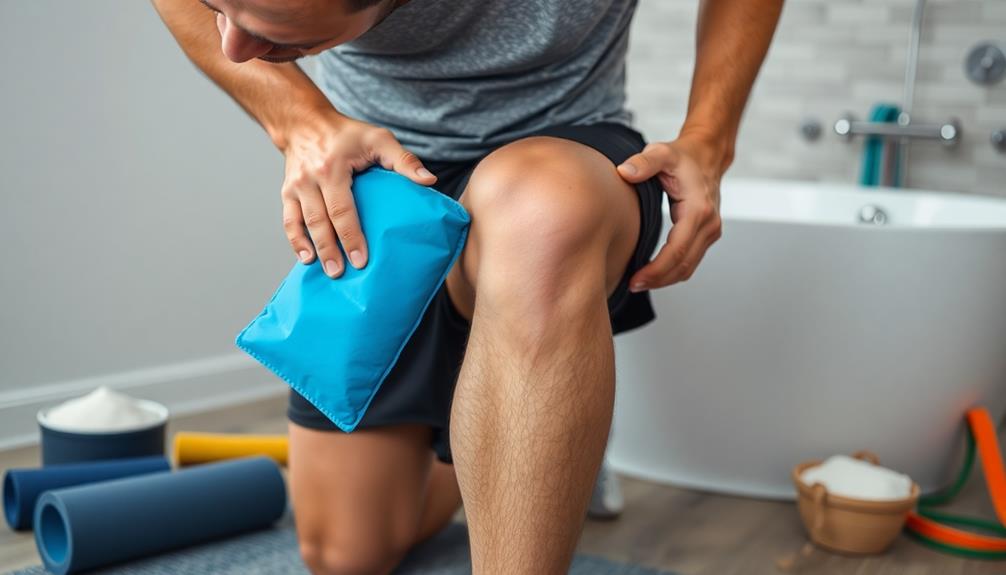To alleviate extreme soreness after leg day, start with immediate recovery strategies. Hydrate with water and electrolyte-rich drinks, consume protein and carbs, and engage in light exercises to boost circulation. Stretch your main leg muscles and use a foam roller. Focus on proper nutrition, including protein-rich meals and anti-inflammatory foods. Incorporate static and dynamic stretches, along with mobility exercises. Consider tart cherry juice or magnesium supplements for their anti-inflammatory properties. Get plenty of rest and optimize your sleep. If soreness persists or worsens, consult a medical professional. Discover more effective techniques to speed up your recovery and get back to crushing your workouts.
Core Insight
- Hydrate adequately with water and electrolyte-rich beverages to replenish fluids lost during exercise and support recovery.
- Consume a balanced mix of protein and carbohydrates to aid muscle repair and replenish energy stores.
- Perform light exercises and stretches to improve circulation and reduce muscle stiffness.
- Use foam rolling and compression clothing to target tight muscles and reduce inflammation.
- Consider tart cherry juice or magnesium supplements for their potential anti-inflammatory and muscle recovery benefits.
Understanding Post-Leg Day Soreness
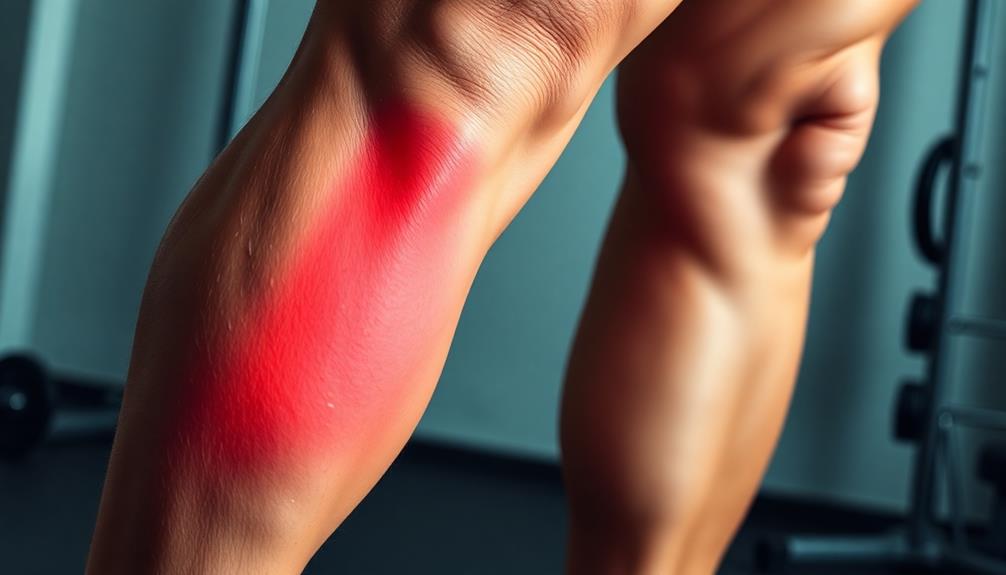
Intense muscle soreness after a tough leg workout is common among fitness fans. This soreness, called Delayed Onset Muscle Soreness (DOMS), is usually worst 24-48 hours post-exercise. It's caused by tiny tears in muscle fibers during hard exercise. Eating right and taking supplements to keep electrolytes balanced can help ease soreness and speed up recovery.
While some soreness is normal when building muscle, severe DOMS can be crippling. How sore you get depends on:
- How intense your workout is
- The type of exercise (eccentric moves often cause more soreness)
- Your fitness level
- How hydrated you are
- What you eat
Knowing this can help you manage and reduce soreness after leg day. Remember, being sore doesn't always mean you had a great workout. And not being sore doesn't mean your workout was bad. The key to making progress is balancing hard work with proper recovery.
Immediate Post-Workout Recovery Strategies
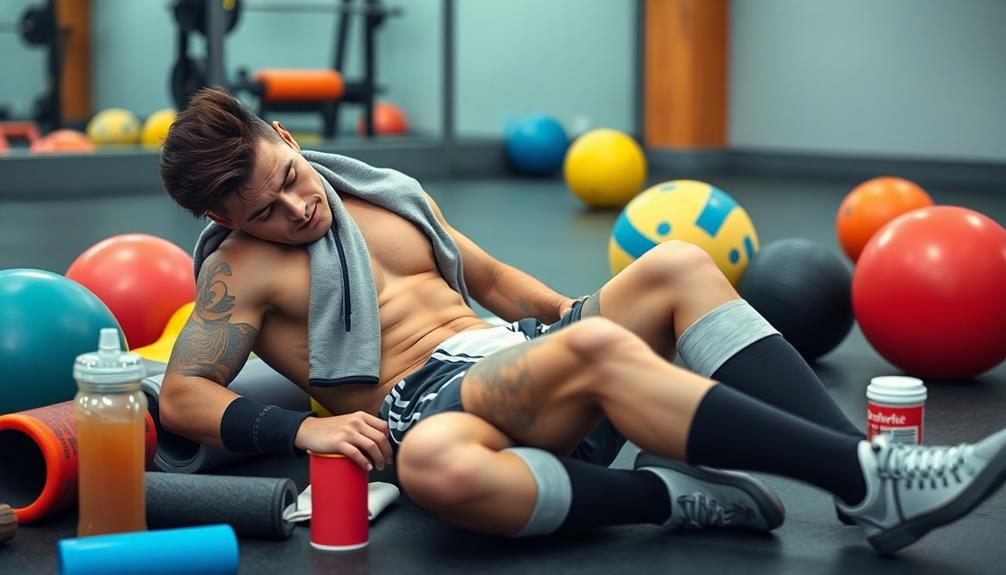
After your leg workout, try these three strategies to speed up recovery. First, drink plenty of water to replace fluids lost through sweating. You can also use hydration powders with minerals and vitamins for better results. Second, eat a meal or drink a shake with protein and carbs to repair muscles and restore energy. Third, do some light exercises to get your blood flowing and loosen tight muscles.
For even better recovery, you can also:
- Stretch your main leg muscles
- Use a foam roller to massage your muscles
- Take a cool shower to reduce swelling
- Wear compression clothing to support circulation
- Put your legs up to minimize swelling
Hydration and Electrolyte Balance
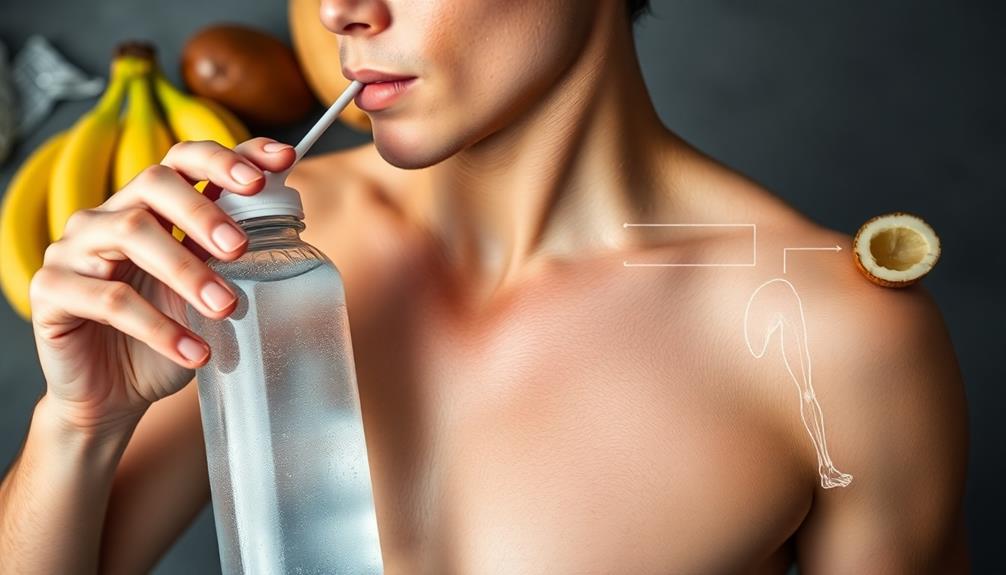
Staying hydrated and maintaining the right balance of electrolytes are key for recovering after leg day. When you work out hard, you sweat out fluids and important minerals, which can make you dehydrated and your muscles tired. To avoid this, drink water regularly all day long, not only during exercise. Hydration powders are a good way to put back electrolytes and keep your fluid levels where they should be, especially when you've had a tough leg workout. These powders usually have essential minerals like sodium, potassium, magnesium, and calcium that your muscles need to work and recover well.
To bounce back better, think about adding drinks with electrolytes to your routine. Sports drinks, coconut water, or electrolyte solutions you make at home can all help. They'll give you back the sodium, potassium, and magnesium you lose when you exercise.
Keep an eye on the color of your pee. It should be light yellow. If it's darker, drink more fluids. Just remember, staying hydrated isn't only about drinking water. It's about keeping the right mix of fluids and electrolytes in your body. That's what helps your muscles recover and stops them from getting too sore.
Nutrition for Muscle Recovery
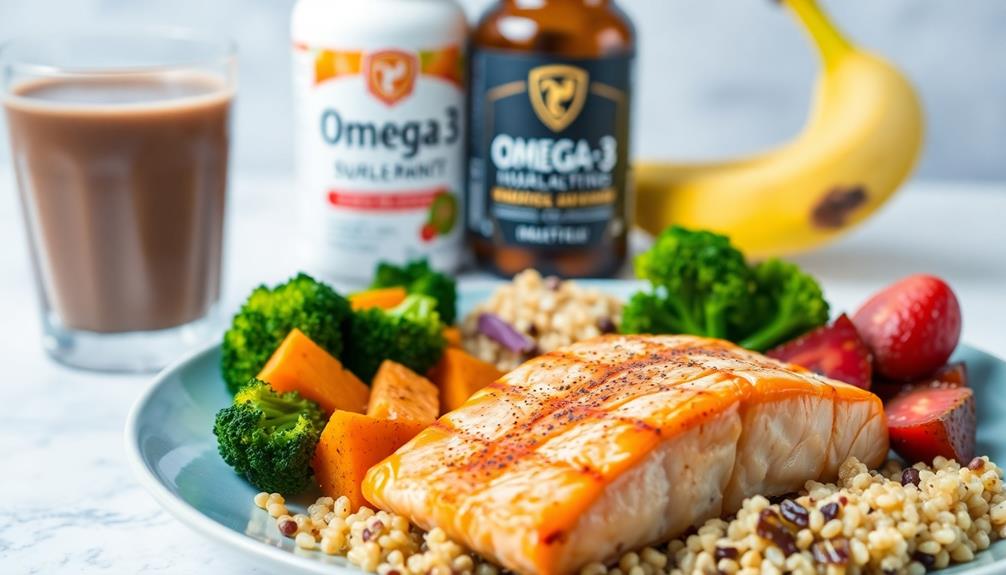
Nutrition is key for muscle recovery after an intense leg workout. To help your body heal, eat a balanced mix of protein, carbs, and fats. Protein is especially important for repairing and rebuilding muscle. Try to eat a protein-rich meal or snack within 30 minutes of your workout. Protein bars can be an easy choice, giving you 15-30g of protein to support muscle recovery and growth. When picking a protein bar, think about the balance of carbs and protein, the quality of ingredients, and any dietary needs you have.
Include these important nutrients in your post-leg day meals:
- High-quality proteins like lean meats, fish, eggs, or plant-based options
- Complex carbs to refill your energy stores
- Healthy fats to regulate hormones and reduce inflammation
- Fruits and veggies rich in antioxidants to fight oxidative stress
- Key vitamins and minerals, like vitamins C, D, E, magnesium and zinc
Be sure to eat well throughout the day, not just right after your workout. This will enhance your recovery and reduce muscle soreness.
Stretching and Mobility Exercises

Stretching and mobility exercises are great for reducing muscle soreness after leg day. Gentle static stretches are a good place to start. Hold each stretch for 15-30 seconds, focusing on your quads, hamstrings, calves, and glutes. Dynamic stretches like leg swings and walking lunges can also help increase blood flow and flexibility. Cooling towels on your legs can provide relief for up to 3 hours.
Foam rolling targets tight muscles and fascia. Roll each muscle group for 30-60 seconds, especially any sore spots. Don't forget mobility exercises for your hips and ankles, like hip circles and ankle rotations. These exercises can help improve your recovery after a tough leg workout.
Foam Rolling Techniques

Foam rolling is a great way to soothe sore leg muscles after a tough workout. It helps ease tension and speeds up recovery. For the best results, use a dense foam roller made for deep massage. These rollers are tough and keep their shape, even with heavy use. Focus on rolling these key areas:
- Quads
- Hamstrings
- Calves
- IT Band
- Glutes
Put the roller under the sore muscle. Slowly roll back and forth with firm, steady pressure. When you find a tender spot, stop and hold for 20-30 seconds. This releases knots and tightness in the muscle. Take deep breaths and try to relax, even if it's a bit painful. It's okay to feel some discomfort, but it shouldn't be agonizing. Spend 1-2 minutes on each muscle. You can adjust the pressure by putting more or less body weight on the roller.
Rest and Sleep Optimization

Rest and sleep are essential for recovering after an intense leg workout. When you sleep, your body repairs muscle tissue, so aim to get 7-9 hours of quality rest each night. Make your bedroom cool, dark, and quiet to create an ideal sleep environment. Stick to a regular bedtime routine to let your body know it's time to relax. Wearing compression sleeves on your legs while you sleep can boost blood flow and ease inflammation, helping with soreness as you recover.
Between leg workouts, make sure to rest for at least 48 hours before working the same muscles again. This allows time for your legs to recover and get stronger. If you're dealing with lingering soreness, try gentle stretching or low-impact exercises like swimming or cycling. These types of active recovery can increase blood flow and reduce stiffness without putting too much stress on your muscles.
Active Recovery Methods
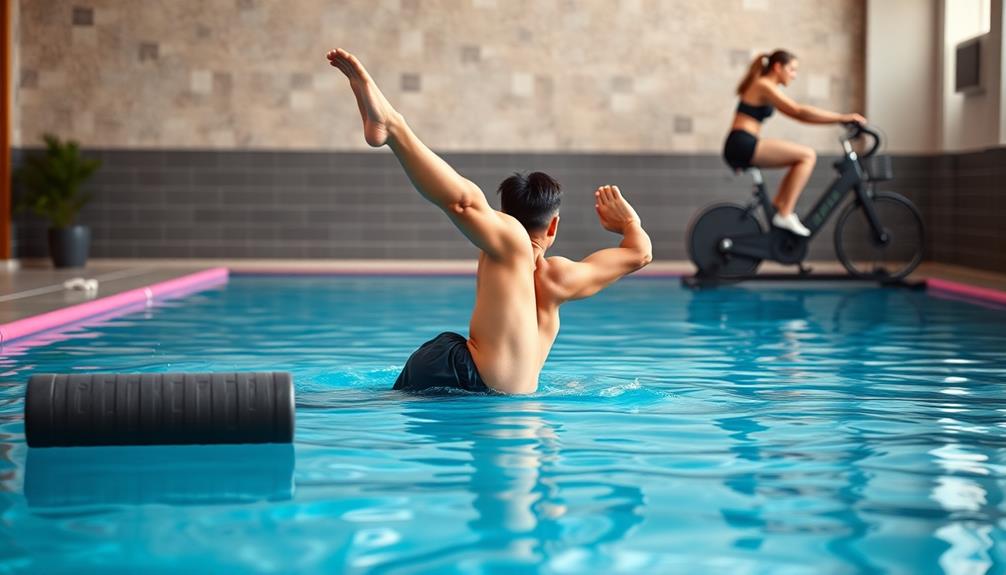
Active recovery can help reduce muscle soreness after an intense leg workout. Instead of resting completely, try light activities to improve blood flow and decrease stiffness. This helps remove waste products and brings nutrients to your muscles, making you feel better faster. Using recovery massage products can also help by focusing on specific muscles and boosting circulation.
Try these active recovery methods:
- Walking or jogging lightly
- Swimming or water exercises
- Easy yoga or stretching
- Biking with low resistance
- Simple mobility exercises
Do these activities on rest days for 15-30 minutes at a low intensity. Pay attention to your body and don't overdo it. If you have severe pain, talk to a doctor. Active recovery can reduce soreness and improve flexibility, helping you get ready for your next workout.
Supplements for Muscle Soreness
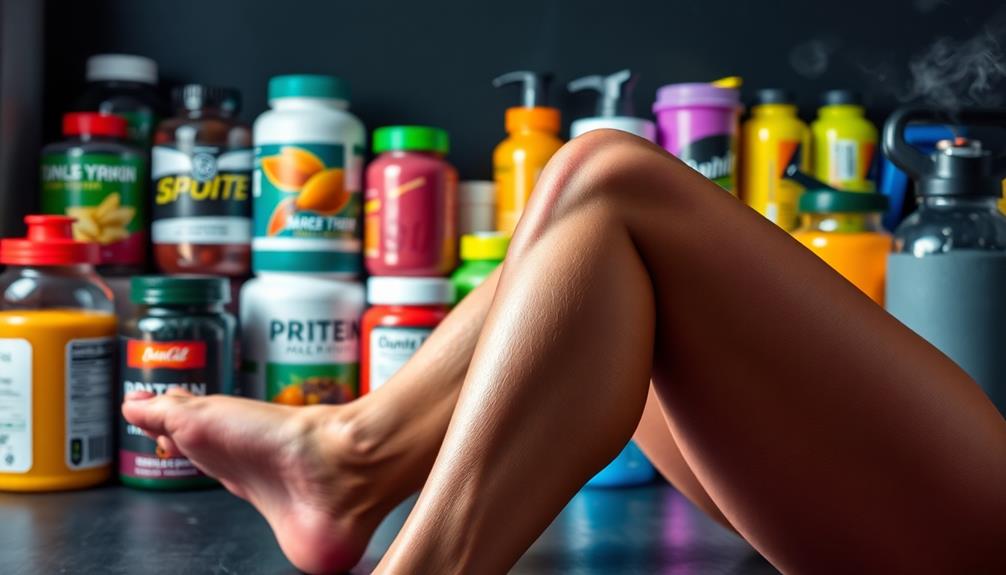
Certain supplements may help reduce muscle soreness after a tough leg day. Fish oil has omega-3 fatty acids that can lower inflammation and muscle damage. BCAAs aid muscle recovery and decrease soreness when taken before and after your workout. HMB supplements also show promise in helping muscles recover and lowering damage from exercise. They come in different forms to fit your preferences.
Turmeric's active ingredient, curcumin, is a strong anti-inflammatory that can lessen muscle pain. Tart cherry juice has lots of antioxidants and may reduce muscle damage and soreness. Magnesium supplements are also helpful since this mineral is important for muscles to work and recover well.
Before taking supplements, talk to your doctor or a nutritionist to find the right amounts and combinations for you. Keep in mind that supplements should be used along with a healthy diet and good training plan, not in place of them.
When to Seek Medical Attention

Most muscle soreness after leg day is normal and doesn't need a doctor. But watch out for these warning signs:
- Bad pain that doesn't get better in a few days
- Swelling that gets worse or doesn't go away
- Red or warm skin near the sore muscle
- Fever or chills with the muscle soreness
- Trouble moving the leg or arm
If you have any of these, see a doctor. Also, if you have a health condition or take medicine that could affect healing, talk to your doctor. They can help you know if the soreness is okay or if something else is wrong. When in doubt, it's smart to check with a doctor. While recovering, think about taking supplements for brain health. They can help your mind stay sharp and focused during workouts.
Frequently Asked Questions
Can I Prevent Soreness by Gradually Increasing Workout Intensity Over Time?
Yes, you can prevent soreness by gradually increasing workout intensity. You'll build tolerance and strengthen muscles over time. Start with lower weights and fewer reps, then slowly progress. This approach allows your body to adapt and reduces post-workout pain.
How Long Does It Typically Take for Extreme Leg Soreness to Subside?
You'll typically experience extreme leg soreness for 2-4 days. It's at its peak 24-48 hours post-workout. By day 5-7, you should feel much better. Remember, everyone's recovery time varies based on fitness level and workout intensity.
Are Cold Water Immersion Baths Effective for Alleviating Post-Leg Day Soreness?
Yes, cold water immersion baths can be effective for reducing post-leg day soreness. You'll find they help decrease inflammation and muscle damage. They're most beneficial when you take them shortly after your workout. Give them a try!
Can Wearing Compression Garments During and After Workouts Reduce Muscle Soreness?
Yes, wearing compression garments can help reduce muscle soreness. You'll likely experience less pain and swelling when you use them during and after your workouts. They improve blood flow and may speed up recovery time.
Is It Safe to Use Over-The-Counter Pain Medication for Post-Leg Day Soreness?
You can safely use over-the-counter pain meds for post-leg day soreness. They'll help reduce inflammation and discomfort. However, don't rely on them regularly. It's better to focus on proper recovery techniques and gradually increase your workout intensity.

